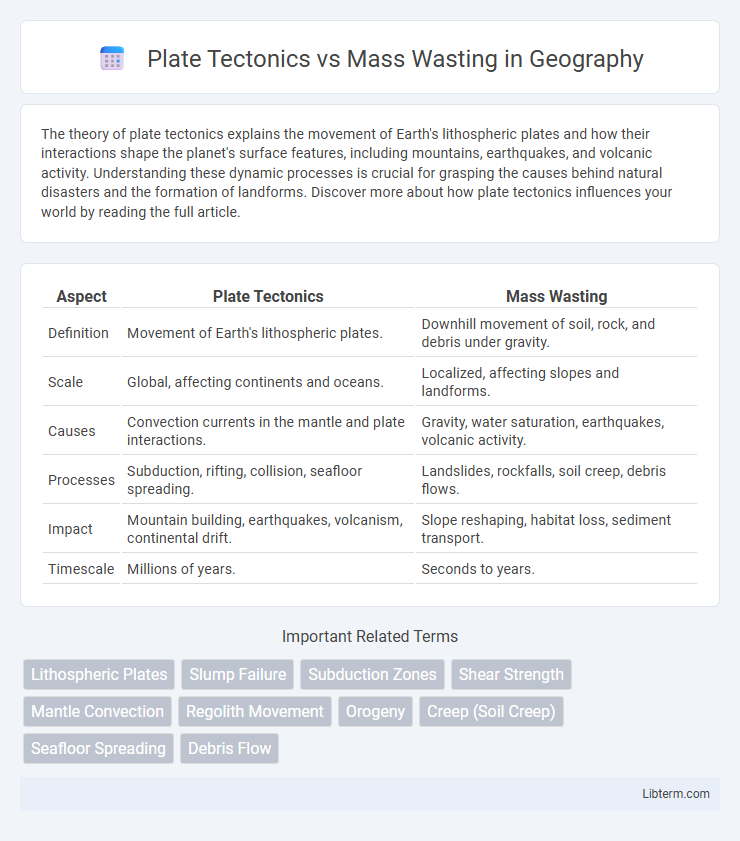The theory of plate tectonics explains the movement of Earth's lithospheric plates and how their interactions shape the planet's surface features, including mountains, earthquakes, and volcanic activity. Understanding these dynamic processes is crucial for grasping the causes behind natural disasters and the formation of landforms. Discover more about how plate tectonics influences your world by reading the full article.
Table of Comparison
| Aspect | Plate Tectonics | Mass Wasting |
|---|---|---|
| Definition | Movement of Earth's lithospheric plates. | Downhill movement of soil, rock, and debris under gravity. |
| Scale | Global, affecting continents and oceans. | Localized, affecting slopes and landforms. |
| Causes | Convection currents in the mantle and plate interactions. | Gravity, water saturation, earthquakes, volcanic activity. |
| Processes | Subduction, rifting, collision, seafloor spreading. | Landslides, rockfalls, soil creep, debris flows. |
| Impact | Mountain building, earthquakes, volcanism, continental drift. | Slope reshaping, habitat loss, sediment transport. |
| Timescale | Millions of years. | Seconds to years. |
Introduction to Plate Tectonics and Mass Wasting
Plate tectonics refers to the movement of Earth's lithospheric plates, causing geological phenomena like earthquakes, volcanic activity, and mountain formation. Mass wasting involves the downhill movement of soil, rock, and debris due to gravity, often triggered by factors such as rainfall, earthquakes, or human activity. Both processes shape the Earth's surface but operate through different mechanisms: plate tectonics through large-scale crustal shifts and mass wasting through surface material displacement.
Defining Plate Tectonics: Earth's Dynamic Crust
Plate tectonics refers to the movement and interaction of Earth's lithospheric plates, which form the planet's dynamic crust responsible for shaping continents and ocean basins. These tectonic plates constantly shift due to mantle convection, leading to geological phenomena such as earthquakes, volcanic activity, and mountain building. Unlike mass wasting, which involves gravity-driven surface material movement, plate tectonics operates on a global scale, driving the long-term evolution of Earth's surface.
Understanding Mass Wasting: Gravity-Driven Processes
Mass wasting refers to the gravity-driven movement of soil, rock, and debris downslope, fundamentally influenced by slope angle, material composition, and water content. Unlike plate tectonics, which involves large-scale lithosphere movements shaping Earth's surface over millions of years, mass wasting occurs rapidly or gradually at localized sites, leading to landslides, rockfalls, and soil creep. Key factors affecting mass wasting include gravitational force overcoming material strength and slope stability, making it a critical process in landscape evolution and natural hazard assessment.
Key Differences Between Plate Tectonics and Mass Wasting
Plate tectonics involves the movement of Earth's lithospheric plates driven by mantle convection, resulting in phenomena like earthquakes, mountain building, and volcanic activity. Mass wasting refers to the downslope movement of soil, rock, and debris under gravity's influence, including landslides, rockfalls, and soil creep. Key differences include tectonic processes shaping Earth's large-scale crustal structure over millions of years, while mass wasting is a surface process causing localized landform changes often triggered by slope instability or external factors like rainfall.
Mechanisms Driving Plate Tectonics
Plate tectonics is driven primarily by mechanisms such as mantle convection, slab pull, and ridge push, which cause the movement of Earth's lithospheric plates. Mantle convection involves the slow creeping motion of Earth's solid silicate mantle caused by convection currents carrying heat from the interior to the surface. In contrast, mass wasting involves the downslope movement of soil and rock under gravity, which does not drive plate motion but is influenced by tectonic uplift and seismic activity.
Triggers and Types of Mass Wasting Events
Plate tectonics drives the movement of Earth's lithospheric plates, creating geological forces such as earthquakes and volcanic activity that can act as primary triggers for mass wasting events. Mass wasting encompasses various types of gravity-driven soil and rock movements, including landslides, rockfalls, mudflows, and creep, each triggered by factors like seismic vibrations, slope saturation, and human activities. Earthquakes induced by plate tectonic stress frequently initiate rapid mass wasting events, while volcanic eruptions and tectonic uplift modify slope stability over time, increasing susceptibility to mass wasting.
Geological Impacts of Plate Tectonics
Plate tectonics drives the formation of mountain ranges, earthquakes, and volcanic activity by the movement of Earth's lithospheric plates along divergent, convergent, and transform boundaries. These geological processes reshape the planet's surface, influence climate patterns, and contribute to the rock cycle through subduction and uplift. In contrast, mass wasting primarily redistributes sediment on slopes through gravity-driven movements, affecting local topography rather than causing large-scale geological transformations.
Environmental Consequences of Mass Wasting
Mass wasting significantly alters landscapes by triggering landslides, debris flows, and rockfalls, leading to habitat destruction and increased sedimentation in rivers, which disrupt aquatic ecosystems. These rapid slope movements contribute to soil erosion, reducing land fertility and increasing the risk of downstream flooding due to sediment accumulation. Unlike plate tectonics, which operates over geological time scales, mass wasting events cause immediate environmental impacts that demand urgent mitigation strategies to protect biodiversity and human infrastructure.
Human Interactions and Risk Management
Plate tectonics drives the formation of earthquakes and volcanic eruptions that significantly impact human settlements, requiring advanced monitoring systems and land-use planning to mitigate risks. Mass wasting events, such as landslides and rockfalls, present localized hazards exacerbated by deforestation, construction, and slope destabilization, demanding soil stabilization techniques and early warning systems. Integrating geological assessments from tectonic activity with slope stability analysis enhances risk management strategies, improving disaster preparedness and reducing casualties in vulnerable communities.
Conclusion: Comparing Plate Tectonics and Mass Wasting
Plate tectonics drives large-scale geological processes like mountain building, earthquakes, and volcanic activity, shaping Earth's surface over millions of years. Mass wasting involves the downslope movement of soil and rock due to gravity, causing rapid, localized surface changes such as landslides and debris flows. While plate tectonics influences long-term crustal deformation, mass wasting results in immediate landform alterations, highlighting their differing spatial and temporal scales in landscape evolution.
Plate Tectonics Infographic

 libterm.com
libterm.com